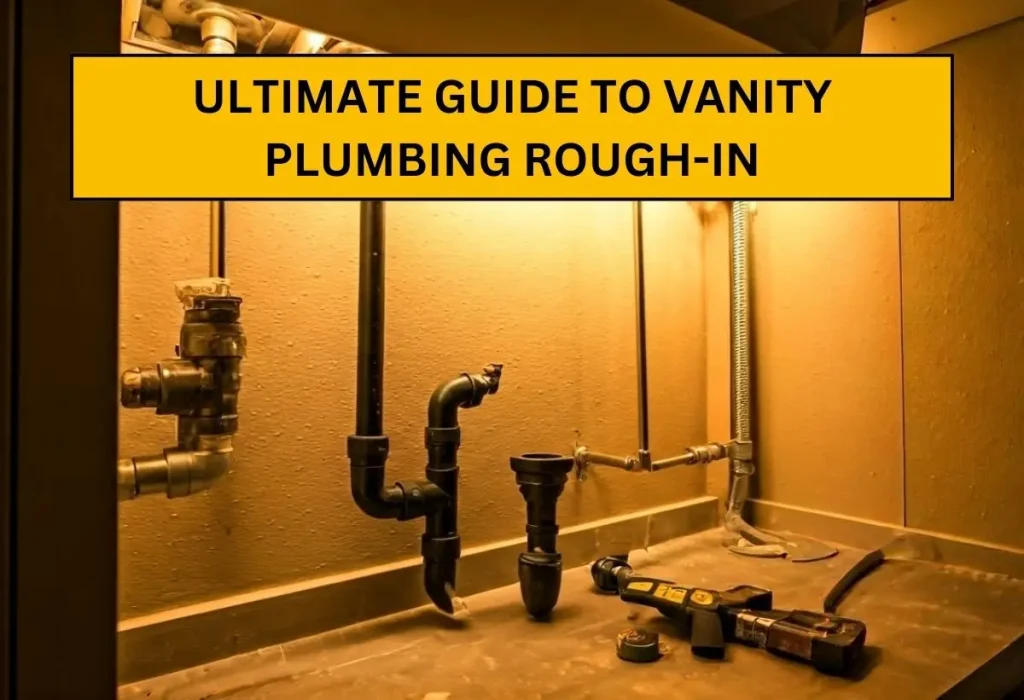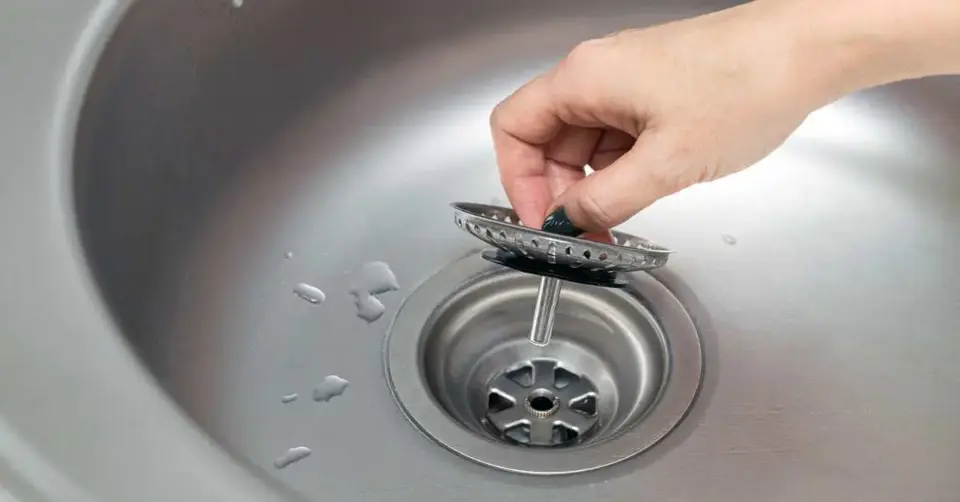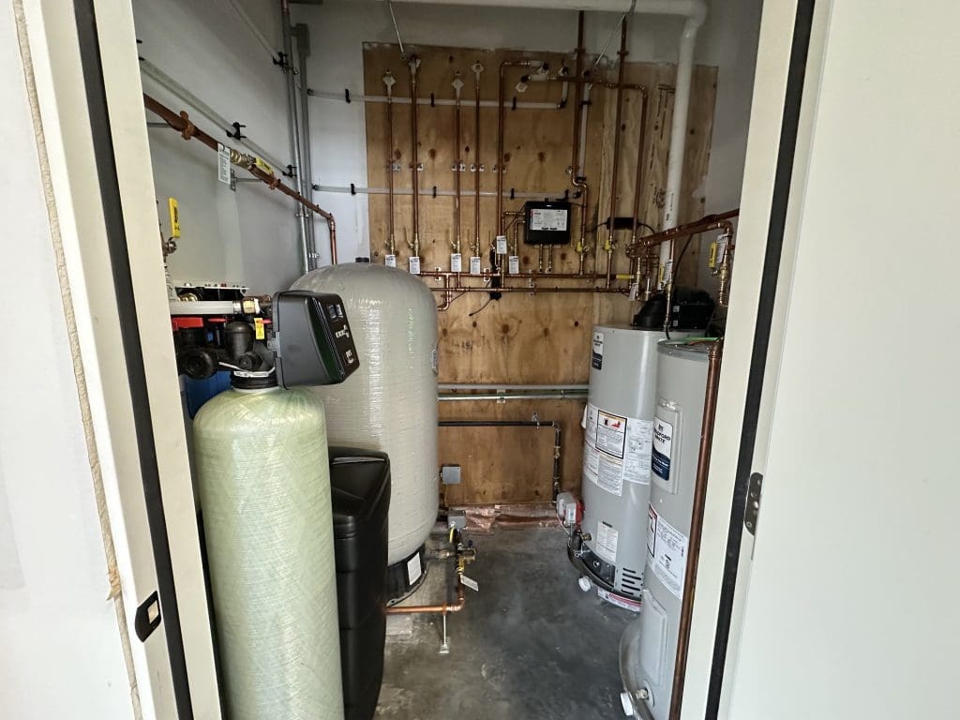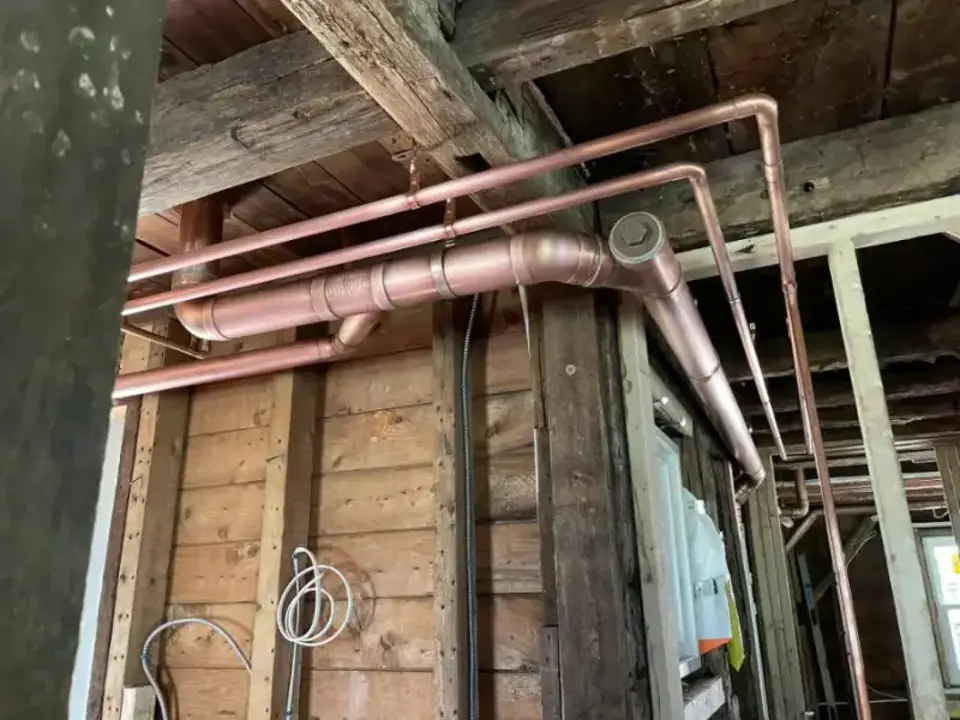Managing bathroom plumbing can be tough, especially during a renovation. One key part you need to think about is the vanity rough-in. This step usually happens during the early building stage or before the walls go up. It includes properly placing the water supply lines and drain pipes inside the unfinished wall. This is where your bathroom vanity will go later.
Understanding Vanity Plumbing Rough-In
Before going into details, it’s important to know what vanity plumbing rough-in means. Simply put, it is about putting in the “hidden” plumbing for your bathroom vanity before sealing the walls. This work includes placing the drain pipes for the sink and the hot and cold water supply lines that connect to the faucet.
A good rough-in is key to a working and nice-looking vanity. It affects where your sink and faucet go and shapes your bathroom layout.
The Basics of Vanity Plumbing Rough-In
The key parts of a vanity rough-in are the drain and the water supply lines. The drain, which is usually a 1.5-inch pipe, takes wastewater from the sink to the main sewer line. It’s important that this pipe is set at the right slope for good drainage.
The water supply lines are typically made of copper or PEX. These lines bring hot and cold water to the faucet. They are usually 1/2 inch wide and should be at a standard height for easy connection to the faucet valves.
When the rough-in is planned well, it means these parts are installed correctly. This helps prevent leaks, drainage problems, and other issues.
Importance of Functionality and Aesthetics
The way you set up the plumbing for your vanity is important for both how it works and how your bathroom looks. If supply lines are not placed correctly, you might have to make messy changes to your vanity. This could also limit the faucets you can choose from. For example, if the lines are too close to the wall, it will be hard to install the faucet without awkward bends or kinks.
Also, if the rough-in is done poorly, it might make the sink look crooked, which can be very noticeable and unpleasant. Following the right measurements and codes during this stage will help ensure your vanity and sink are set up perfectly and look good.
Furthermore, when the rough-in is done with care, it keeps the plumbing hidden inside the walls. This gives your bathroom a clean, seamless look. It also helps with finishing the walls and removes the need for large access panels, which improves the overall look of the space.
Standard Dimensions for Vanity Plumbing
Specific sizes may differ a bit due to local rules and your project needs. However, some common measurements are usually the same for vanity plumbing rough-ins. Knowing these dimensions can help you plan your bathroom layout better. It helps in making sure it works well and looks nice.
These measurements include how high the drainpipe will be from the floor. They also cover the spacing between hot and cold water supply lines. Lastly, these lines need to be at a certain distance from the wall and the centerline of the sink. Sticking to these standards helps your plumbing parts fit just right with your vanity and work well.
Water Supply Lines: Placement and Height
For most standard vanity setups, the water supply lines should be 8 inches apart from center to center. This distance gives enough space for faucet installation and allows for easy use. The height of these lines from the finished floor is usually about 21 inches, but this can change depending on the type of sink and vanity you have chosen.
It is important to think about the backsplash or countertop material when deciding the final height of the supply lines. You need to make sure the lines can connect easily to the faucet valves but remain hidden once everything is installed.
These are basic guidelines, and your specific needs might differ based on the fixtures you choose, the size of the vanity, and local plumbing codes. Always check the manufacturer’s instructions for your fixtures. It can also help to talk to a plumber to find the best placement and height for your water supply lines.
Drain Pipe & Vent Pipe Specifications
The drain pipe for a vanity sink is usually 1.5 inches wide. It connects to the P-trap. The P-trap helps to keep sewer gases out of the bathroom. The drain pipe should be in the middle of the sink, and it needs to be high enough for good drainage.
Also, a vent pipe is important. It helps control air pressure in the plumbing and allows for smooth drainage. This is usually a 1.5-inch pipe that joins the drain line and goes up through the roof.
The placement and path of the vent pipe are very important. They have to meet building codes, so careful planning is needed. To make sure the drain and vent pipes are put in correctly, it’s good to talk to a licensed plumber.
Key Components and Their Roles
Understanding how each part works in a vanity rough-in plumbing system can make the process easier. It can also help stop future problems. The pipes carry water to and from the sink, and the fittings connect the pipes. Every part is important for the system to work well.
Good installation and high-quality materials are key. The drainpipe should be sloped correctly to stop water from collecting. The P-trap must be installed properly, too. This creates a solid seal against sewer gases.
Materials for Water Supply Lines: PEX, Copper, CPVC
Choosing the right material for your water supply lines is very important for the long life of your plumbing system. There are three main choices you can use: PEX, copper, and CPVC. Each material has its own benefits and downsides.
PEX, which stands for cross-linked polyethylene, is a flexible and strong material. It has become very popular recently. PEX resists corrosion and scale, making it easy to care for. Copper is a classic choice that is known for its strength and resistance to bacteria, but it usually costs more than PEX.
CPVC, or chlorinated polyvinyl chloride, is a hard plastic pipe. It is not too expensive and is easy to install. However, CPVC does not handle high temperatures as well as PEX or copper. The best material for your project will depend on your budget, local codes, and what you need.
Importance of Drain Pipe Slope and P-Trap
A key part of a good plumbing system is the right slope of the drain pipe. A small downward slope, about 1/4 inch for every foot of pipe, helps wastewater flow easily to the main sewer line. This prevents clogs and backups.
The P-trap, which looks like a “U” or a “P,” is very important. It stops sewer gases from coming into your bathroom. It does this by keeping a bit of water inside after each use. This water forms a seal that keeps harmful gases out. Make sure the P-trap is set at the right height and angle for it to work well.
If the P-trap is wrongly placed or gets clogged, it can cause bad sewer smells and health risks. It’s important to maintain it by cleaning the P-trap regularly. This will keep it clear and ensure it works properly.
Step-by-Step Guide to Rough-In Process
It’s a good idea to hire a licensed plumber for your bathroom plumbing needs. However, knowing the steps of a vanity rough-in can help you, too.
First, you should plan and measure based on your vanity size and local codes. Then, you install the drain line, making sure it has the right slope. After that, you place the vent pipe for good ventilation. Lastly, you install the water supply lines at the right height and distance, which are ready to connect to the faucet valves.
Planning, Measurement, and Code Compliance
Before you start the rough-in process, you need to plan carefully and take precise measurements. First, know the size of your vanity. This includes where the sink will go, where the faucet will be placed, and how many water lines you need.
Then, check your local building codes. Make sure that where you want to put the drainpipe, water supply lines, and vent pipes follows these rules. It’s important to think about things like how far the pipes are from walls, what sizes the pipes should be, and what materials you can use.
Taking the time to plan and measure accurately will help you avoid costly mistakes later. Remember, following the code keeps your plumbing system safe and working for a long time. It can stop potential dangers and expensive repairs from happening in the future.
Installation Techniques for Water and Drain Pipes
Installing the water and drain pipes correctly is crucial for the functionality and longevity of your vanity plumbing. The drain line requires a proper slope to ensure efficient wastewater flow, while the water supply lines need to be securely fastened to prevent leaks.
Various techniques are employed for different pipe materials. For instance, PEX pipes require specialized crimp tools, while copper pipes necessitate soldering. Use appropriate pipe hangers or clamps to secure the pipes to the framing and prevent sagging or movement, which could lead to leaks over time.
| Pipe Material | Installation Technique |
| PEX | Crimping |
| Copper | Soldering |
| CPVC | Solvent Welding |
Custom Vanity Considerations
Standard bathroom plumbing setups usually fit common designs. However, custom vanities might need changes for the pipes and fixtures. For example, a floating vanity requires running the plumbing lines inside the wall instead of using the floor. This needs careful planning and precise work.
It is important to find the exact spots for all the vanity parts, like drawers, shelves, and plumbing. This way, the rough-in plumbing won’t block their use. Also, keep in mind how heavy a custom vanity can be, especially if it uses materials like stone. You may need to strengthen the wall framing for support.
Adjustments for Floating and Double Sink Vanities
Floating vanities look modern and stylish, but they can be tricky when it comes to plumbing. Since these vanities connect directly to the wall and don’t touch the floor, the plumbing has to be hidden inside the wall. This means you must plan well to place the drain and supply lines correctly. They should match the location of the sink while taking into account where the vanity mounts.
Double sink vanities come with their own set of challenges. With two sinks next to each other, you need separate supply lines and drainpipes, each requiring its own P-trap. It’s important to keep enough space between the lines. This helps to avoid problems and makes the faucet and drain assembly installations easier.
It’s smart to talk to a professional plumber who knows how to install custom vanities. They can offer great advice, help you follow the codes, and make sure the plumbing fits well with your vanity’s design.
Solutions for Compact Bathrooms and Specialty Designs
In small bathrooms, it is very important to make the best use of each inch of space. This means finding smart ways to set up the plumbing for the sink. For example, using wall-mounted faucets can save space on the countertop. This choice needs the plumbing lines to be put higher inside the wall.
Corner sinks are also a good option to make the most of the space. However, their plumbing lines must be carefully moved around the corners and must follow the right angles and clearances. For special items like vessel sinks, the drainpipe needs to line up exactly with the sink’s drain hole. This often requires custom solutions that go beyond regular plumbing practices.
Good preparation and teamwork with skilled plumbers are very important for small bathrooms and unique designs. Creative ideas, like using flexible PEX tubing for tight areas or special fittings for odd angles, can help create a bathroom that works well and looks great.
Tackling Common Challenges
A good vanity plumbing rough-in can help avoid problems, but unexpected issues can still happen. One issue may be misaligned pipes. This happens when the drain or supply lines do not match up with the fixtures of the vanity. This can cause problems during installation.
Another issue could be finding surprises during the rough-in work. This may include old wiring or parts of the building inside the wall. This might require changes to the plumbing layout that was originally planned. Fixing these problems often calls for some creative problem-solving. You may need to use offset fittings to adjust pipe locations or change the path of the pipes to go around any obstacles.
Preventing Misalignments and Installation Delays
To prevent misalignments, start with accurate measurements. Double-check the vanity’s size with the plumbing layout. While doing the rough-in, make sure to use a level. This will help you keep the drainpipe straight up and the water supply lines level across.
Before sealing the walls, do a dry fit for the vanity and fixtures. Temporarily put in the vanity, faucet, and drain. This helps you check that everything fits together right and there are no clearance problems. Spotting and fixing misalignments early can save you from expensive redo work. It will also help make the installation process easier.
Always communicate clearly with your plumber. Paying careful attention to detail is important to prevent misalignments. This will help your vanity plumbing rough-in go smoothly.
Avoiding Material Incompatibility and Venting Issues
Using materials that work well together in your plumbing system is key. This helps stop leaks and keeps everything lasting a long time. If you mix different metals like copper and galvanized steel, it might cause galvanic corrosion. This is when one metal breaks down because of a chemical reaction.
Problems with venting can make your drainage slow, cause gurgling sounds, and might even let sewer gas into your bathroom. Make sure the vent pipe is the right size, has a good slope, and is clear of any blockages. This will help air to flow well in the plumbing system.
Talking to a licensed plumber during your planning is helpful. They can make sure you pick the right materials and take care of venting issues before they happen. It is very important to follow the local plumbing codes and the advice from manufacturers about pipe materials, fittings, and venting. This is crucial for a safe and efficient plumbing system.
Post-Installation Maintenance Tips
Once your vanity plumbing rough-in is done and the fixtures are in place, it’s important to follow some maintenance tips. This will help keep your plumbing system in good shape for a long time.
Check regularly for leaks, especially around the pipe connections and under the sink. Finding small issues now can stop them from becoming big problems later.
In addition, avoid clogs by not letting hair and soap build up in the drain. You should also flush the drain with hot water every so often. This helps keep the drainage working well and stops bad smells from happening.
Routine Leak Inspections and Drain Cleaning
Regularly checking your vanity plumbing for leaks is important. It helps stop water damage and keeps your environment safe. At least once a year, look closely at all the pipes, connections, and fittings under the sink. Check for any water droplets, stains, or damp spots.
Also, check the area around the base of the vanity and the floor for signs of leaks. A slow leak might be hard to spot, but it can cause big damage over time. Don’t forget to check the faucet for leaks. Pay special attention to the base and the handles.
To avoid clogged drains and keep good drainage, create a cleaning routine. Once a month, pour a mix of baking soda and vinegar down the drain. Follow this with hot water to help clear out soap scum and hair.
The Value of Professional Check-Ups
Routine maintenance is important for your vanity plumbing. However, it is best to schedule professional check-ups at least every few years. A licensed plumber has the skills and tools to find hidden leaks and pressure issues. They can spot problems that you might not see.
During a check-up, the plumber will look closely at all plumbing parts. This includes the supply lines, drain lines, shut-off valves, and P-trap. They will check the water pressure and look for signs of corrosion, leaks, or damage.
Finding issues early can lead to quick repairs. This helps prevent expensive damage and keeps your plumbing system working well. A professional plumber can also give you advice about maintenance. They can answer any questions you have and help protect your investment.
Why Choose Pro Elite Plumbing & Heating?
Trusted Experience
With more than 20 years in the industry, we’ve worked on everything from simple vanity setups to intricate custom designs. No matter the challenge, we know how to get the job done right and built to last.
Licensed and Insured Professionals
Our technicians are fully licensed, insured, and trained to handle all types of plumbing work. We stay updated on modern techniques and local building codes, so every project is handled safely and professionally.
Clear and Honest Pricing
Surprises aren’t fun when it comes to costs. That’s why we provide upfront, detailed quotes before starting any job. You’ll always know what to expect, with no hidden fees or last-minute changes.
Customer-Focused Care
We treat your home like it’s our own. From the first conversation to the final cleanup, we make sure the process is smooth and stress-free. Our goal is to leave you with results you love and an experience that feels easy and hassle-free.
Ready to Perfect Your Vanity Plumbing?
Don’t let plumbing challenges hold up your project. Call Pro Elite Plumbing & Heating today for expert vanity plumbing rough-in services in Dutchess County, NY. From precise installations to reliable solutions, we’ve got you covered. Contact us now for a consultation and let’s bring your bathroom vision to life!
Frequently Asked Questions
What’s the standard height for vanity water lines?
The typical height for water supply lines is about 21 inches from the finished floor to the centerline of the pipe. This height can change depending on the fixtures you choose and the bathroom layout. It’s important to think about the height of your sink and the front buffer needed to hide the supply lines behind the vanity.
Can I adjust the rough-in placement for a custom vanity?
Yes, changes to the rough-in plumbing are often needed for custom vanities. The plumbing layout should be planned carefully. This helps to fit the specific design and provides enough clearance for drawers and other parts inside.
How much does vanity rough-in plumbing cost?
The price of vanity rough-in plumbing can change a lot. It depends on what place you are in, how hard the job is, and what materials you choose. It is a good idea to talk to a local plumber. They can give you a precise estimate for your project.
What tools are needed for vanity rough-in?
Vanity rough-in plumbing needs special plumbing tools. You will need pipe cutters, wrenches, measuring tapes, and maybe soldering tools or PEX crimpers. The tools you use depend on the type of pipe material.
Is venting necessary for every vanity setup?
Yes, venting is important for nearly every vanity setup. Vent pipes keep drainage working well. They stop air pressure problems in the plumbing system. This helps avoid slow drainage and keeps sewer gas from coming into your home.
Can I combine vanity plumbing with my bathtub or tub plumbing?
Yes, it’s possible to combine vanity plumbing with your bathtub or tub plumbing, depending on your bathroom layout. We can connect the systems to maximize efficiency, using properly placed tee fittings for clean and smooth water flow.
How far should the vanity plumbing rough-in be from the back wall?
For most setups, the drainpipe should be approximately 18–20 inches from the back wall, while the water supply lines should be 20–22 inches. These measurements provide the perfect alignment for your bathroom sink plumbing and ensure your sink bowl sits flush with the vanity.
What type of piping is best for vanity plumbing rough-in?
We often use PVC pipes for their durability and ease of installation. PVC is resistant to corrosion and handles water discharge well, making it an ideal choice for most bathroom setups.
Should I include a cleanout in my vanity plumbing?
Adding a cleanout is a smart move to make future maintenance easier. A cleanout allows easy access to clear blockages in the drain without needing to disassemble the entire system. We recommend placing it near the vanity for quick access.
Can I DIY my vanity plumbing rough-in?
While some DIY enthusiasts may attempt vanity plumbing, it’s a tricky process that requires precise measurements and knowledge of local codes. Incorrectly installed systems can cause problems with your tub spout, spout, or overall drainage. Hiring a professional like Pro Elite Plumbing & Heating ensures the job is done right the first time.






